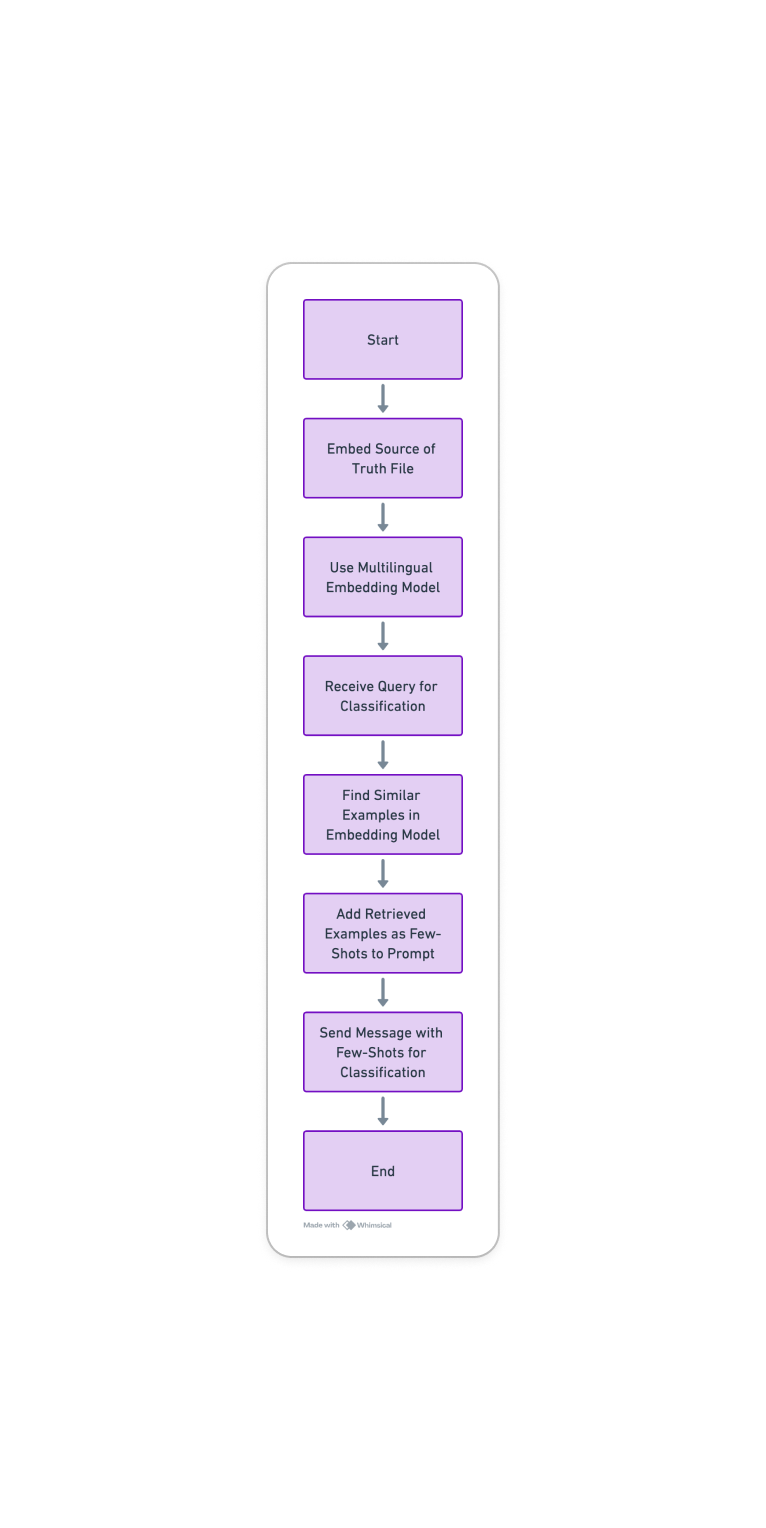Development
Overview
The application uses a Language Model (LLM) with GPT-4 at its core for intent recognition. The process involves embedding input data, utilizing a multilingual model for dynamic example selection, and performing intent classification with a few-shot learning approach. Below are the detailed steps following the flow chart provided.
Detailed Process Flow

1. Embed Source of Truth File
- Purpose: Create embeddings for the few-shot examples that serve as the "source of truth."
- Procedure: Input the few-shot examples into GPT-4, which generates a vector representation of each example.
2. Use Multilingual Embedding Model
- Functionality: Facilitate the understanding and processing of messages in multiple languages.
- Selection: Dynamically choose the relevant embeddings based on the language and content of the incoming query.
3. Receive Query for Classification
- Reception: The system accepts an incoming user query that needs to be classified.
- Pre-processing: Standardize the query to match the format expected by the model (e.g., lowercasing, removing special characters).
4. Find Similar Examples in Embedding Model
- Search: Within the multilingual embedding space, identify few-shot examples with high similarity to the received query.
- Criteria: Examples are selected based on semantic similarity and language relevance.
5. Add Retrieved Examples as Few-Shots to Prompt
- Integration: The selected few-shot examples are combined with the query to create a new prompt for GPT-4.
- Contextualization: This step ensures that the context for the classification is set correctly, which is particularly important for the few-shot learning approach.
6. Send Message with Few-Shots for Classification
- Classification Request: The prompt consisting of the query and few-shot examples is fed to GPT-4.
- GPT-4 Processing: GPT-4 analyzes the combined input to understand the intent of the query by drawing parallels with the provided few-shot examples.
7. Classification
- Outcome: GPT-4 outputs the classification of the query's intent.
- Post-Processing: The result may then be used to trigger corresponding action handlers or responses within the application.
Action Handlers and Response Functions
- Purpose: Design specific functions/handlers to address common intents such as greetings, feedback, acknowledgments, marking spam, and language preference management.
- Implementation:
- Develop a set of predefined response templates for each intent category.
- Create a function dispatcher that routes the classified intents to their respective handlers.
- Database Integration:
- Ensure each handler is capable of updating the user's status or preferences in the application's unified database.
- This update mechanism is crucial for maintaining consistent communication and personalizing the user experience.
- Dynamic Response Generation:
- Integrate with GPT-4 Functions to dynamically generate responses for intents that require more nuanced or context-specific information.
Additional Technical Considerations
- Multilingual Capability: The system must accurately handle and classify queries across different languages, necessitating the use of a robust multilingual model.
- Dynamic Example Selection: To accommodate the variability in user queries, the embedding model must be capable of selecting the most appropriate few-shot examples on-the-fly.
- Few-Shot Learning: This approach allows the application to effectively classify intents with minimal training data per category, as GPT-4 can generalize from a few examples.
By following these steps, the application leverages the powerful capabilities of GPT-4 for intent recognition, while also ensuring adaptability and accuracy through the use of multilingual embeddings and dynamic few-shot example selection.